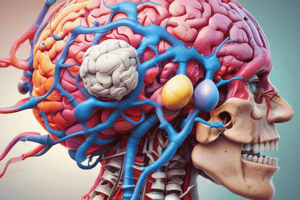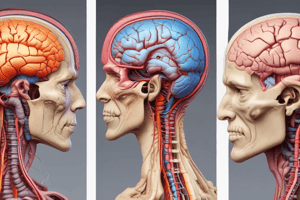Podcast
Questions and Answers
What is the reason for the reddish hue of the red nucleus?
What is the reason for the reddish hue of the red nucleus?
- Due to the presence of a zinc-containing pigment
- Due to its proximity to the cerebral aqueduct
- Due to its vascularity and the presence of an iron-containing pigment (correct)
- Due to the presence of a copper-containing pigment
Which of the following is NOT a source of afferent fibers to the red nucleus?
Which of the following is NOT a source of afferent fibers to the red nucleus?
- Lentiform nucleus
- Cerebral cortex
- Inferior colliculus (correct)
- Cerebellum
What is the name of the tract through which efferent fibers from the red nucleus pass to the spinal cord?
What is the name of the tract through which efferent fibers from the red nucleus pass to the spinal cord?
- Rubroreticular tract
- Rubrospinal tract (correct)
- Corticospinal tract
- Spinocerebellar tract
What is the name of the structure that contains the corticospinal, corticonuclear, and corticopontine fibers at the level of the superior colliculi?
What is the name of the structure that contains the corticospinal, corticonuclear, and corticopontine fibers at the level of the superior colliculi?
Which of the following is a destination of efferent fibers from the red nucleus?
Which of the following is a destination of efferent fibers from the red nucleus?
What is the name of the reference textbook that provides information about the red nucleus?
What is the name of the reference textbook that provides information about the red nucleus?
What information is carried by the lateral lemniscus?
What information is carried by the lateral lemniscus?
What is the primary function of the substantia nigra?
What is the primary function of the substantia nigra?
Which structure is situated between the tegmentum and the crus cerebri?
Which structure is situated between the tegmentum and the crus cerebri?
What is the function of the superior colliculus?
What is the function of the superior colliculus?
What is the pathway of the fibers of the oculomotor nucleus?
What is the pathway of the fibers of the oculomotor nucleus?
What is the composition of the crus cerebri?
What is the composition of the crus cerebri?
Which structure is connected to the lateral geniculate body by the superior brachium?
Which structure is connected to the lateral geniculate body by the superior brachium?
What is the location of the medial, spinal, and trigeminal lemnisci?
What is the location of the medial, spinal, and trigeminal lemnisci?
What is the primary function of the inferior colliculus?
What is the primary function of the inferior colliculus?
Which cranial nerve is associated with the trochlear nucleus?
Which cranial nerve is associated with the trochlear nucleus?
Where is the mesencephalic trigeminal nucleus located?
Where is the mesencephalic trigeminal nucleus located?
What is the function of the medial lemniscus?
What is the function of the medial lemniscus?
Where do the emerging fibers of the trochlear nucleus pass?
Where do the emerging fibers of the trochlear nucleus pass?
What is the function of the spinal lemniscus?
What is the function of the spinal lemniscus?
Where is the inferior colliculus located in relation to the cerebral aqueduct?
Where is the inferior colliculus located in relation to the cerebral aqueduct?
What is the pathway of the auditory information after the inferior colliculus?
What is the pathway of the auditory information after the inferior colliculus?
Study Notes
Midbrain Organization
- The midbrain is situated between the tegmentum and the crus cerebri.
- The substantia nigra is a large motor nucleus concerned with muscle tone, located in the midbrain.
- The crus cerebri contains important descending tracts, including the corticospinal and corticonuclear fibers.
Sensory Pathways
- The lateral lemniscus carries information about sound from the cochlear nucleus to various brainstem nuclei and ultimately the inferior colliculi.
- The medial lemniscus transports sensory spinothalamic information of conscious proprioception, vibration, fine touch, and 2-point discrimination of skin and joints of the body and head.
- The spinal lemniscus is responsible for the transmission of pain, temperature, and crude touch to the somatosensory region of the thalamus.
- The trigeminal lemniscus conveys tactile, pain, and temperature impulses from the skin of the face and the mucous membranes of the nasal and oral cavities.
Visual Reflexes
- The superior colliculus lies beneath the corresponding surface elevation, forms part of the visual reflexes, and is connected to the lateral geniculate body by the superior brachium.
- The superior colliculus receives afferent fibers from the optic nerve, the visual cortex, and the spinotectal tract.
Oculomotor Nucleus
- The oculomotor nucleus is situated in the central gray matter close to the median plane.
- The fibers of the oculomotor nucleus pass anteriorly through the red nucleus to emerge on the medial side of the crus cerebri in the interpeduncular fossa.
Red Nucleus
- The red nucleus is a part of the midbrain, posterior to the cerebral aqueduct.
- The red nucleus has four small surface swellings, including the two superior and two inferior colliculi.
- Afferent fibers reach the red nucleus from the cerebral cortex, cerebellum, lentiform nucleus, subthalamic and hypothalamic nuclei, substantia nigra, and spinal cord.
- Efferent fibers leave the red nucleus and pass to the spinal cord, reticular formation, thalamus, and substantia nigra.
Other Nuclei
- The trochlear nucleus is situated in the central gray matter and is responsible for transmitting proprioception from the oro-facial region.
- The mesencephalic trigeminal nucleus is responsible for receiving and transmitting proprioception from the oro-facial region.
- The inferior colliculus is a part of the auditory pathway and receives many of the terminal fibers of the lateral lemniscus.
Studying That Suits You
Use AI to generate personalized quizzes and flashcards to suit your learning preferences.
Description
This quiz covers the structure and functions of various brain parts, including the lateral lemniscus, substantia nigra, and their roles in sensory perception and motor control.




